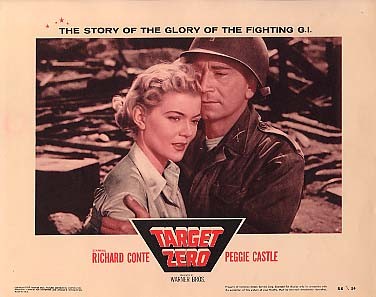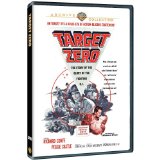| Reviews & Columns |
|
Reviews DVD TV on DVD Blu-ray 4K UHD International DVDs In Theaters Reviews by Studio Video Games Features Collector Series DVDs Easter Egg Database Interviews DVD Talk Radio Feature Articles Columns Anime Talk DVD Savant Horror DVDs The M.O.D. Squad Art House HD Talk Silent DVD
|
DVD Talk Forum |
|
|
| Resources |
|
DVD Price Search Customer Service #'s RCE Info Links |
|
Columns
|
|
|
Target Zero
A Warner Archive release, Target Zero is presented in 16:9 enhanced widescreen, approximating its original screen shape, but the transfer is also mighty soft, probably sourcing secondary film elements. No extras.
On the front lines, United Nations relief workers Ann Galloway (Peggy Castle), a biochemist, and Sue (Angela Loo) crash their vehicle after some shelling. Sue is killed instantly and Ann is knocked cold for five hours. She comes to and is greeted by survivors a British tank crew led by Sgt. David Kemsemmit (Richard Wyler) who tells her that, while she was unconscious, North Korean troops have taken over the area and that they're now stuck behind enemy lines.
They're soon joined by survivors of an American patrol, also without a working radio, led by Lt. Tom Flager (Richard Conte). He orders the American-hating Kemsemmit and the crew of the Phyllis II to accompany them as they attempt to rejoin their American company on a distant ridge that may already have been taken by the Reds. Flager orders Ann to look after a seriously injured soldier, Pvt. Dan O'Hirons (Strother Martin).
The patrol consists of the usual movie military types. Sgt. Vince Gaspari (Charles Bronson) is the circumspect professional soldier, fiercely loyal to Flager; Pvt. Felix O'Hara (L.Q. Jones) the genial hick; Pvt. Moose (Chuck Connors) the dedicated radio operator determined to make contact with their far-off regiment; Pvt. "Geronimo" (Abel Fernandez) the quietly efficient scout. More survivors of the recent battle, two "plumbers," (mortar men), Pvts. George (John Dennis) and Strangler (future TV producer Aaron Spelling), join them. They're a Mutt & Jeff pair, the former tall and hulking and despite constant bellyaching protective of his diminutive, scarecrow-like partner.
Predictable adventures and suspense ensue. They get trapped in a minefield, where Strangler is seriously injured and Ann faints at the sight of the injured man. (The film implies without showing anything that his broken arm has pierced through his skin.) Later on, the tank runs low on gas, prompting Flager to risk ambushing a convoy, the end result of which is one particularly gruesome death.
The film works, however, partly because of the screenplay by James Warner Bellah, an American Western writer whose stories were the basis for Fort Apache, She Wore a Yellow Ribbon, and who wrote the script for The Man Who Shot Liberty Valance; and Sam Rolfe, who'd written The Naked Spur and who would go on to create Have Gun - Will Travel. Their credits would certainly explain the Western flavor to the meaninglessly titled Target Zero, which would have worked equally well had it been about lost U.S. Cavalrymen. It keeps the drama confined to the immediate vicinity of the American and British soldiers, while the North Korean and or Chinese are almost always seen from a great distance. One clever bit has Ann and the nervous British tank crew briefly imagine/hallucinate Asian faces on what turns out to be Flager's men. Similar ideas turn up in the Twilight Zone episode "A Quality of Mercy," whose story was suggest by Rolfe.
The supporting cast is strong, though Bronson, Connors, and especially Strother Martin are underutilized. Bronson is seen but doesn't speak a word until 20 or so minutes into the film, while Martin hardly speaks at all, is mostly carted around hidden under a blanket, and practically unrecognizable. However, L.Q. Jones, the actor born Justus E. McQueen but who adopted the name of his character in Battle Cry (also 1955), gets a lot of quality screentime.
Best of all are Richard Conte and Peggy Castle. She was a sultry but intelligent and strong green-eyed blonde similar to Jan Sterling (Ace in the Hole) but dropped out of acting after co-starring on the Lawman TV series. She was, sadly, an alcoholic whose problems grew worse in the 1960s and she died in 1973 when she was just 45. In Target Zero though she's entirely believable, her performance rising well above her character's limitations.
Richard Conte is also playing a familiar character: the tough but enormously respected leader with the weight of the world on his shoulders, who sets aside his personal fears and feelings to ensure that his men come back alive. However, the actor plays this part to perfection, making the viewer wonder why he never really maintained a starring career, instead gradually easing into character parts. He worked steadily from the mid-1940s until his death in 1975, first establishing himself in war movies before finding his niche in film noir. Conte was excellent in that genre, notably in leading parts in Thieves' Highway (1949), The Blue Gardenia (1953), and The Big Combo (1955), though he's perhaps best remembered for his supporting part in the James Stewart film Call Northside 777 (1948). His Italian-American roots led to an occasional film with Frank Sinatra (notably Oceans' Eleven, in which he's very good) and as Don Corleone's rival, Don Barzini,, in The Godfather (1972). Around this time Conte also began appearing in Italian-made crime films, sometimes delivering his lines in Italian, sometimes in English.
His contrasting features (dark, gentle eyes, soft voice yet brooding features and a generally pained expression) typically led to his casting as gangsters and foreign (sometimes Middle Eastern) villains, but here he excels as a cool-headed lieutenant keeping his men in line with understated leadership.
The picture itself was a medium-level production, neither very big nor quite a B-movie. Most of it was shot in or around Ft. Carson in Colorado Springs. Near the end there's some exceptionally dangerous-looking low-flying bombing raid by jet aircraft that swoops over the cast shockingly close and fast. Even Conte looks genuinely startled in one shot.
Video & Audio
Though properly formatted to 16:9 enhanced widescreen, the B&W Target Zero is unaccountably soft, with the Warner Bros. logo especially murky in this regard. Though the film has remained with Warners since its release nearly 60 years ago, the transfer seems sourced from secondary elements, not the original camera negative, and day-for-night scenes suffer particularly. The audio, English only with no subtitle options, is okay, however. No Extra Features.
Parting Thoughts
A surprisingly good little war movie sourcing less than pristine film elements, Target Zero is nonetheless worthwhile and Recommended.
Stuart Galbraith IV is the Kyoto-based film historian and publisher-editor of World Cinema Paradise. His credits include film history books, DVD and Blu-ray audio commentaries and special features.
|
| Popular Reviews |
| Sponsored Links |
|
|
| Sponsored Links |
|
|
| Release List | Reviews | Shop | Newsletter | Forum | DVD Giveaways | Blu-Ray | Advertise |
|
Copyright 2024 DVDTalk.com All Rights Reserved. Legal Info, Privacy Policy, Terms of Use,
Manage Preferences,
Your Privacy Choices | |||||||
















